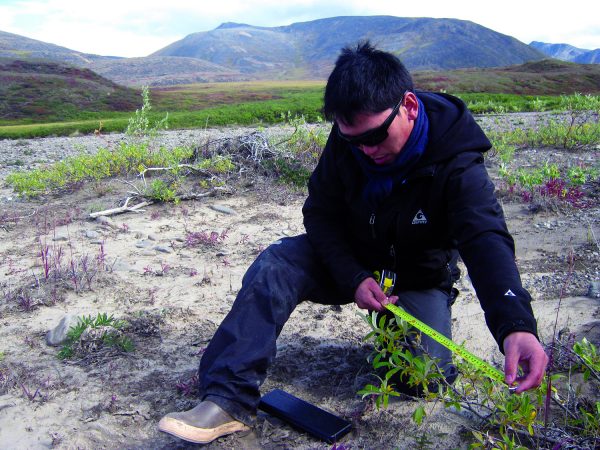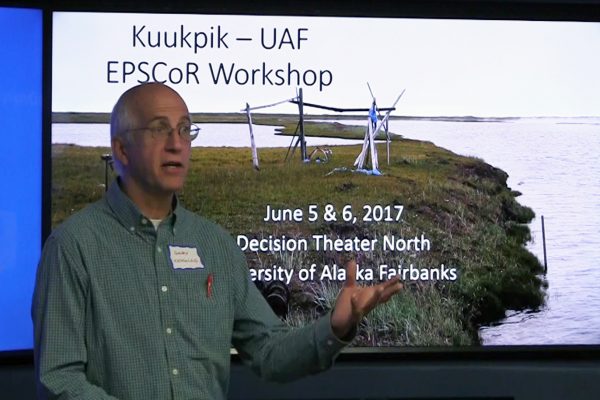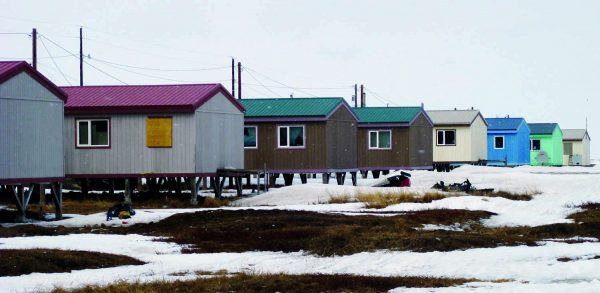Researchers, locals meet to share Nuiqsut knowledge
October 25, 2017
Tom Moran
907-474-5581

Download text and photo captions here.
Gathering two dozen people at UAF to collaborate on research is hardly rare. But when half of them come from an isolated North Slope village almost 400 miles away, the situation becomes decidedly more unusual.
That was the case in early June, when members of the board of directors of the Kuukpik Corp. — the Alaska Native village corporation for the community of Nuiqsut — met with scientists studying the adaptive ability of northern communities.
“We had some of the richest conversation I’ve experienced, where scientists shared what they knew and locals were adding to that and complementing it, and in some cases noting observations and knowledge of the system that the researchers didn’t have,” said Gary Kofinas, a UAF professor of resource policy and management and head of a research effort called the Northern Test Case.
The June workshop was in some ways a culmination of the test case, one of three interdisciplinary studies in different regions of Alaska being conducted by the Alaska National Science Foundation Established Program to Stimulate Competitive Research. The goal of the statewide project is to better understand the capacity of different types of Alaska communities to adapt to change. Nuiqsut a natural fit: In addition to experiencing pronounced climate change, the 400-person village is located near burgeoning oil and gas development.
“We talked about a changing landscape, including a focus on biophysical changes driven in part by climate change and also by changes in land use,” Kofinas said. “And as a part of that we talked about thawing permafrost, resulting in changes in hydrology and water runoff, how those changes affect fisheries, oil and gas development, and their impacts on land and people.”

A dozen Northern Test Case researchers used the high-tech facilities at UAF’s Decision Theater North space to discuss other topics as well, including the expansion of shrubs and their effect on animals, the impacts of airplane overflights on the local soundscape, and the resilience of Nuiqsut’s economy, which relies in part upon subsistence hunting and fishing.
The meeting was designed as a two-way conversation about the attendees’ collective knowledge of change on the North Slope. Kofinas said the event constituted an effort to avoid what he termed “hit-and-run” research, in which scientists study an area without seeking local input into structuring the research and without sharing results for the benefit of locals.
“We are increasingly interested in our research in helping communities to make decisions, informing them, adding to their capacity to adapt to changes,” he said. “It’s also important in terms of learning from the people who live there, who have a perspective that’s at times very different than that of researchers.”
To that end, the 12 members of the Kuukpik board in attendance were given ample opportunities to ask questions and contribute their own observations of change. Kofinas said some of these related directly to the types of physical, biological and social science conducted by EPSCoR, but the input also included surprising comments on subjects such as contaminants potentially being released by thawing permafrost and river erosion.
A tentative follow-up workshop is planned for the coming winter. Kofinas said he expects personal relationships between researchers and Nuiqsut residents to continue.

“For some of the researchers in this room, this was a first-time experience, hearing from people at the local level,” he said. “It’s pretty clear that a lot of the researchers were touched and will think about how they can collaborate with community members and be sensitive to local needs when writing their next proposals. To do that, they now have personal relationships to build on.”
A video about the workshop and other Alaska NSF EPSCoR stakeholder engagement can be viewed at https://www.youtube.com/watch?v=32CpBC25ASw&t=1s.


